Shivaji Maharaj: Biography, Photo, Wallpaper, Spouse
Shivaji Bhonsale I, commonly known as Chhatrapati Shivaji Maharaj, was an Indian emperor and a member of the Bhonsle Maratha family. He was born on February 19, 1630, and passed away on April 3, 1680. The Maratha Empire was founded when Shivaji separated his independent state from the failing Adilshahi sultanate of Bijapuri. He was officially recruited as the Chhatrapati of his domain at Raigad Fort in 1674.
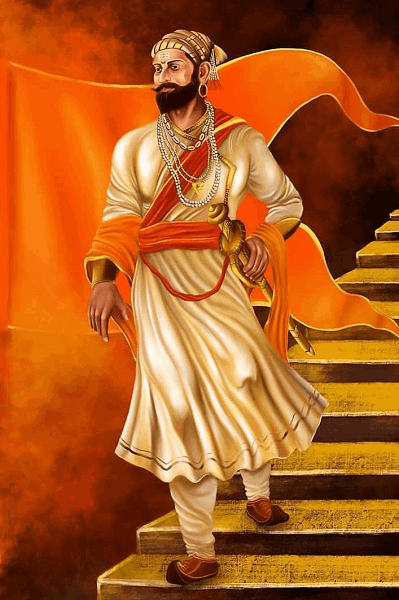
The Mughal Empire, the Sultanate of Golkonda, the Sultanate of Bijapuri, and the European colonial powers were allies and enemies of Shivaji during his lifetime. Shivaji's armed forces extended the Maratha area of control, which also established a Maratha navy and took control of forts. Shivaji developed a capable and forward-thinking civil government with well-organized administrative institutions. He advocated using Marathi and Sanskrit in place of Persian in the court and government and revived traditional Hindu political and court customs.
Shivaji's impact varied depending on the observer and the period. Still, over two centuries after his passing, he gained more prominence when the Indian independence movement emerged, as many Indian nationalists raised him as a proto-nationalist and Hindu hero.
Early Life
Shivaji was born at the hill fort of Shivneri, close to the modern-day city of Junnar in the Pune area. There is lot of dispute on his birthdate amongst the experts. The Maharashtra government designates February 19 as a holiday honoring the birth of Shivaji (Shivaji Jayanti). Shivaji was given the name after the goddess Shivai, a local divinity. The Deccan Sultanates employed Shivaji's father, Shahaji Bhonsle, a Maratha general. Jijabai, the daughter of Lakhuji Jadhavrao of Sindhkhed, a Sardar who supported the Mughals and claimed ancestry from the Yadav royal dynasty of Devagiri, was the mother of the child.
Shivaji was a member of the Bhonsle Clan's Maratha lineage. Maloji, his paternal grandpa, earned the title of "Raja" and was a powerful commander during the Ahmadnagar Sultanate (1552–1597). To cover his military expenditures, he received Deshmukh rights to Pune, Supe, Chakan, and Indapur. Additionally, he received Fort Shivneri for his family to reside in around 1590.
When Shivaji was born, three Islamic sultanates—Bijapuri, Ahmednagar, and Golkonda—shared control of the Deccan. Shahaji frequently switched allegiances between the Nizamshahi of Ahmadnagar, the Adilshah of Bijapuri, and the Mughals, but he never gave up his jagir (fiefdom) in Pune or his minor army.
Background and Context
The Bijapuri Adil Shahi sultanate attacked neighboring nations in 1636. Only recently had the sultanate joined the Mughal empire as a subordinate kingdom. Shahaji, who was at the time a leader in the western Indian Maratha uplands, supported it. Shahaji was looking for chances to receive jagir land awards in countries he had captured, with the ability to annuitize the taxes he would have paid.
Shahaji rebelled during his brief Mughal service. The Bijapuri administration helped Shahaji in his anti-Mughal activities, but they were mostly ineffective. Shivaji and his mother, Jijabai, had to shift from fort to fort due to the Mughal army's endless pursuit of him.
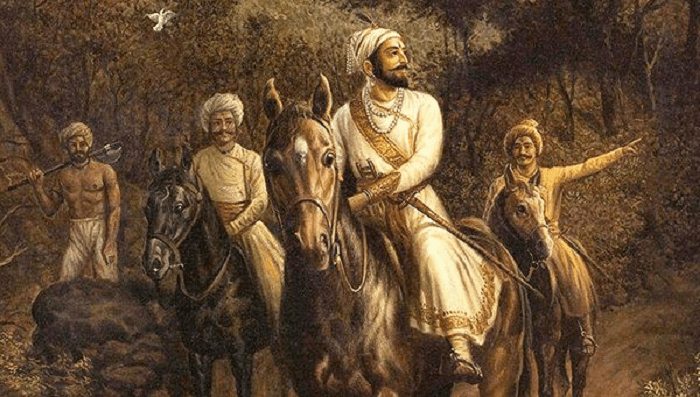
Shahaji joined the Bijapuri army in 1636 and was granted Poona. In Poona, Shivaji and Jijabai made their home. Adilshah, the monarch of Bijapuri, sent Shahaji to Bangalore, where he nominated Dadoji Kondadeo as administrator. Shivaji assumed control of the government after Kondadeo's death in 1647. One of his initial actions involved openly criticizing the Bijapuri regime.
Conflict with Bijapuri Sultanate
In 1646, Sultan Mohammed Adil Shah's illness caused uncertainty in the Bijapuri court, so 16-year-old Shivaji captured the Torna Fort and looted the substantial riches he discovered there. Shivaji conquered numerous significant forts close to Pune during the next two years, including Purandar, Kondhana, and Chakan. He also established direct rule over the regions east of Pune, particularly those around Supa, Baramati, and Indapur. He constructed a new fort called Rajgad using the riches taken from Torna. For more than a decade, that fort housed his administration. Shivaji then took over the important town of Kalyan as he traveled to the Konkan in the west. The Bijapuri government was aware of these events and sought to do something about them. According to the instructions of the Bijapuri administration, Shahaji was arrested on July 25, 1648, by a fellow Maratha Sardar by the name of Baji Ghorpade to keep Shivaji at bay.
When Jinji was captured in 1649, he assured Adilshah's position in Karnataka, and Shahaji was freed. Shivaji took a break from conquering during 1649–1655, gradually consolidating his victories. After freeing his father, Shivaji continued his raids. In 1656, under questionable circumstances, he assassinated Chandrarao More, a fellow Maratha feudatory of Bijapuri, and took the Javali valley, which lies close to the modern hill resort of Mahabaleshwar, from him. Several more houses, many of whom had Deshmukhi rights, supported Adilshahi of Bijapuri in addition to the Bhonsale and the More family. These families included Sawant of Sawantwadi, Ghorpade of Mudhol, Nimbalkar of Phaltan, Shirke, Mane, and Mohite. Shivaji used various tactics to subjugate these strongholds, including marriage alliances, direct negotiations with rural Patils to avoid the Deshmukh, and physical violence. Later in life, Shahaji had a conflicted viewpoint toward his son and renounced his disobedient behavior. He instructed the people of Bijapuri to treat Shivaji however they pleased. In a hunting mishap, Shahaji passed away between 1664 and 1665.
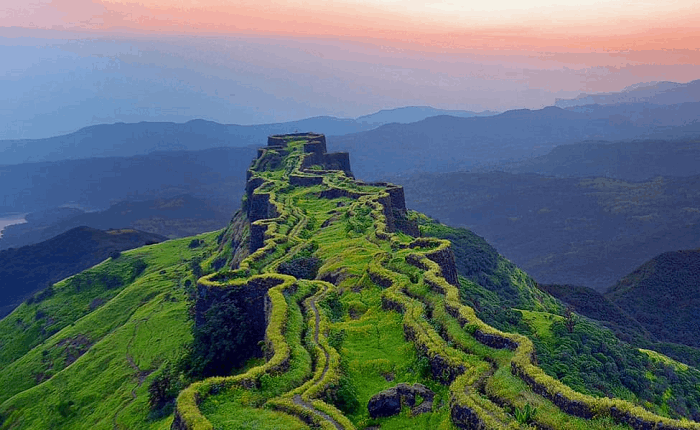
Combat with Afzal Khan
The defeats suffered by the Bijapuri sultanate at the hands of Shivaji's army, which their subordinate Shahaji denied, angered them. The Bijapur administration became more stable and focused on Shivaji after signing a peace pact with the Mughals. The populace recognized the youthful Ali Adil Shah II as the sultan. A seasoned general named Afzal Khan was deployed to capture Shivaji in 1657 by the monarch, most likely by his mother and regent. The Bijapuri soldiers desecrated the Vithoba temple in Pandharpur, an important Hindu pilgrimage site, and the Tulja Bhavani Temple, which is sacred to Shivaji's family and is located near the Tulja Bhavani Temple.
Shivaji fled to the Pratapgad fort while being pursued by Bijapuri forces, where many of his allies urged him to give up. Shivaji could not end the warfare, and Afzal Khan could not capture the fort despite possessing a strong army and the necessary siege tools. After two months, Afzal Khan sent Shivaji a message recommending the two leaders have a secret meeting outside the fort to conduct discussions.
On November 10th, 1659, they had their first encounter in a cabin at the base of Pratapgad fort. Each person had to arrive as planned, carrying only a sword and being accompanied by one companion. Shivaji disguised himself in armor underneath his clothing, had a bagh nakh (a metal "tiger claw") hidden on his left arm, and held a knife in his right hand because he thought Afzal Khan would fight or capture him. The specific events are not recovered with historical certainty. They are still entangled with tales from Marathi sources, but they all concur that the lead characters found themselves engaged in a physical conflict that would be deadly for Khan. Shivaji had Khan disemboweled despite Khan's attempt to puncture Shivaji's armor with his knife. Shivaji then blasted a cannon to warn his covert warriors to assault the Bijapuri army.
Shivaji's army beat the Bijapur Sultanate's soldiers in the subsequent Battle of Pratapgarh, fought on November 10th, 1659. Two Afzal Khan's sons, two Maratha chiefs, one high-ranking Sardar, and more than 3,000 Bijapur army troops were slain or captured. Shivaji staged a magnificent inspection below Pratapgarh following the victory. The captured enemy, officers, and men were set free and sent back to their homes with money, food, and other gifts. Marathas were rewarded accordingly.
Siege of Panhala
In 1659, after conquering the Bijapuri armies sent to attack him, Shivaji's army advanced toward the Konkan and Kolhapur, capturing Panhala fort and routing the Bijapuri soldiers who had sent to attack them under Rustam Zaman and Fazl Khan. In 1660, Adilshah, working with the Mughals who intended to assault from the north, dispatched his commander Siddi Jauhar to invade Shivaji's southern border. Shivaji and his army were positioned at Panhala fort during this time. Panhala was under siege by Siddi Jauhar's army in the middle of 1660, which cut off the fort's supply lines. Siddi Jauhar recruited several English artillerymen to help him attack the fort while flying a flag flown by the English. He also bought explosives from the English at Rajapur to improve his effectiveness. Officers and soldiers kidnapped by the enemy were released and returned to their families with money, food, and other presents. Marathas received adequate compensation.
This apparent betrayal incensed Shivaji, who in December would react by robbing the English factory at Rajapur and kidnapping four players, punishing them until mid-1663. The fort was surrendered to Siddi Jauhar after many months of the siege on September 22nd, 1660, and Shivaji withdrew to Vishalgad. In 1673, Shivaji overthrew Panhala.
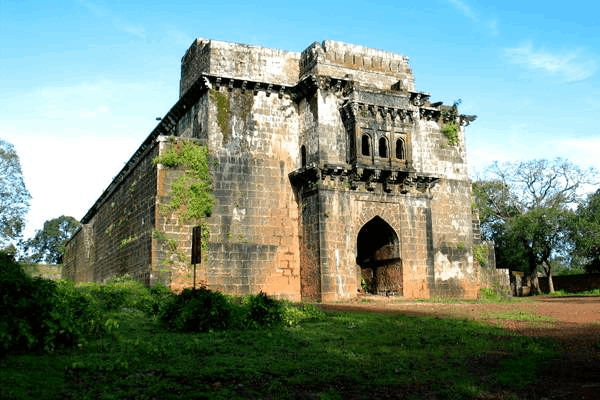
Battle of Pavan Khind
When Shivaji fled Panhala under cover of darkness and was being followed by enemy cavalry, his Marath Sardar Baji Prabhu Deshpande of Bandal Deshmukh, along with 300 troops, agreed to fight to the end to hold back the enemy at Ghod Khind (also known as the "horse ravine") so that Shivaji and the rest of the army could flee to safety within Vishalgad fort.
The smaller Maratha army repelled the bigger adversary during the Battle of Pavan Khind, giving Shivaji enough time to flee. On the evening of July 13th, 1660, Baji Prabhu Deshpande was injured, but he persisted in fighting until he observed cannon fire from Vishalgad, indicating Shivaji had arrived at the fort safely. In memory of Bajiprabhu Deshpande, Shibosingh Jadhav, Fuloji, and all the other warriors who battled there, Paavan Khind, which means "holy pass," was eventually given the name Ghod Khind (khind, which means "a narrow mountain pass").
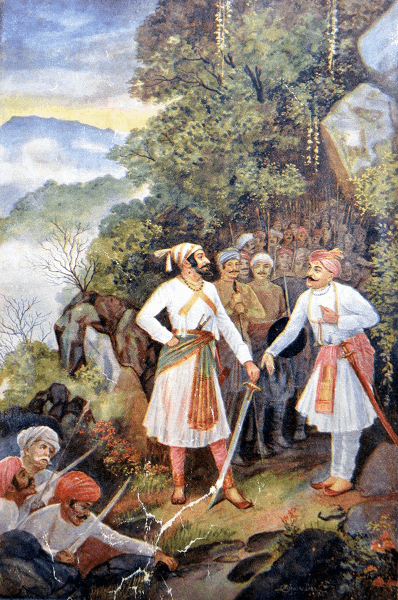
Conflict with the Mughals
Shivaji had close connections with the Mughal Empire up until 1657. In exchange for official confirmation of his claim to the Bijapuri forts and villages in his hands, Shivaji volunteered to help Aurangzeb, who at the time was the Mughal ruler of the Deccan and the son of the Mughal emperor, capture Bijapur. He led an assault on the Mughal Deccan after being unhappy with the Mughal reaction and discovering a better deal in Bijapur. When two of Shivaji's soldiers entered the Mughal area close to Ahmednagar in March 1657, the Mughals first came into conflict with him. Raids were then conducted in Junnar, during which Shivaji stole 200 horses and 300,000 hun (about $3,000) in money. In response to the attacks, Aurangzeb sent Nasiri Khan, who, at Ahmednagar, destroyed Shivaji's soldiers. However, due to the rainy season and his struggle with his siblings for the Mughal throne after Shah Jahan's sickness, Aurangzeb's counterattacks against Shivaji were unsuccessful.
Attacks on Shaista Khan and Surat
In January 1660, Badi Begum of Bijapur requested that Aurangzeb, then the Mughal emperor, send his maternal uncle Shaista Khan with soldiers numbering approximately 150,000 men and a strong artillery division to battle Shivaji with the forces of Bijapur commanded by Siddi Jauhar. Shaista Khan conquered Pune with the help of his 80,000-strong force, which was better armed and supplied. He also captured the neighboring fort of Chakan after besieging it for a month and a half before breaking through the defenses. Shaista Khan took advantage of having a more numerous, well-equipped, and well-armed Mughal force to advance into some Maratha territory, capturing Pune and placing himself as a resident at Shivaji's palace, Lal Mahal.
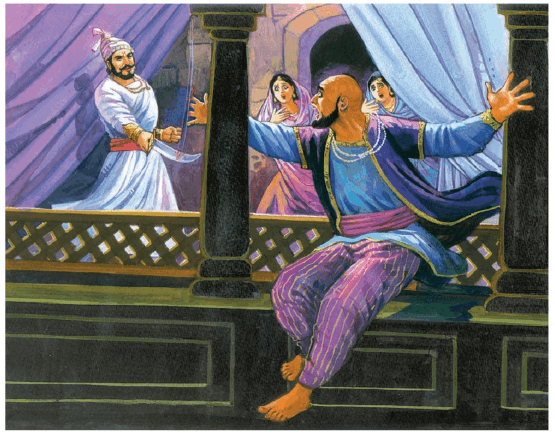
Shivaji oversaw a risky nighttime assault on Shaista Khan's encampment on the evening of April 5, 1663. He and his 400 men stormed into Shaista Khan's home, where they injured Khan in the bedroom. Khan sacrificed his third finger. Shaista Khan's son and numerous wives, servants, and warriors were murdered in the conflict. The Khan sought safety with the Mughal armies outside of Pune, and Aurangzeb sent him to Bengal as retribution for this humiliation. In 1664, Shivaji destroyed Surat, a thriving Mughal commerce hub, as punishment for Shaista Khan's raids and to refill his empty treasury. He also led a naval attack on the Portuguese-held city of Basrur, now in the Indian state of Karnataka, on February 13, 1665, and took a sizable amount of loot.
Treaty of Purandar
Aurangzeb became furious at the assaults on Shaista Khan and Surat. He ordered a force of about 15,000 soldiers under the command of this Rajput leader, Mirza Raja Jai Singh I, to fight Shivaji in return. Jai Singh's army continued to pressurize Shivaji throughout 1665, with their horse riders destroying the surrounding area and their siege soldiers occupying Shivaji's forts. Several of Shivaji's most important commanders and a sizable portion of his warriors were successfully recruited into the Mughal army by the Mughal commander. Shivaji was compelled to reach an agreement with Jai Singh by the middle of 1665 when the fortress at Purandar was under siege and on the verge of being taken.
By signing the Treaty of Purandar with Jai Singh on June 11, 1665, Shivaji promised to surrender 23 of his forts while keeping 12 forts for himself and pay the Mughals 400,000 gold hun in compensatory damages. Shivaji consented to join the Mughal empire as a subordinate and to send his son Sambhaji and 5,000 cavalries to serve as mansabdars for the Mughals in the Deccan.
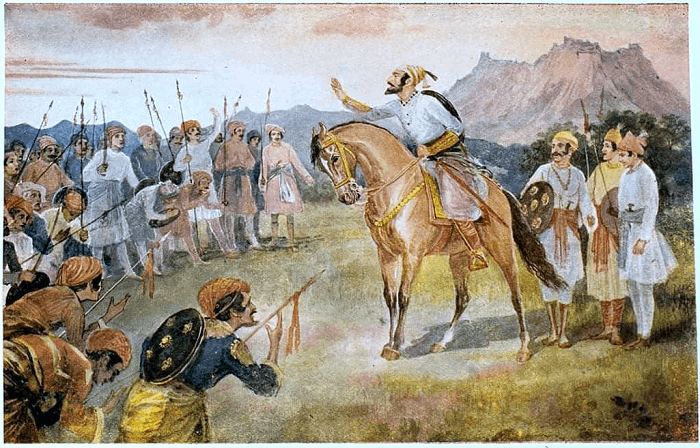
Arrest in Agra and Escape
Aurangzeb invited Shivaji and his nine-year-old son Sambhaji to Agra in 1666 (although some accounts indicate Delhi). Aurangzeb intended to dispatch Shivaji to Kandahar, now in Afghanistan, to solidify the Mughal empire's northwest boundary. Shivaji, who had previously defeated several of these lords in war, was forced to stand next to them in court on May 12, 1666. After taking offense and leaving the courtroom in a rage, Shivaji was immediately placed under home arrest. Shivaji and his son received custody assurances from Ram Singh, the son of Jai Singh.
It was dangerous for Shivaji to be in home detention since Aurangzeb's court debated whether to execute him or keep him on staff. Jai Singh attempted to persuade Aurangzeb to change his mind after assuring Shivaji of his safety. Shivaji developed a strategy to set himself free during this time. He urged Ram Singh to revoke his promises to the emperor about the safe custody of himself and his son, sent most of his soldiers home, and submitted to the Mughal army. Shivaji then sent several enormous baskets filled with sweets to be delivered to the Brahmins and needy as devotion while pretending to be unwell. Shivaji managed to flee and leave Agra on August 17, 1666, by placing himself in one of the enormous baskets and his son Sambhaji in another.
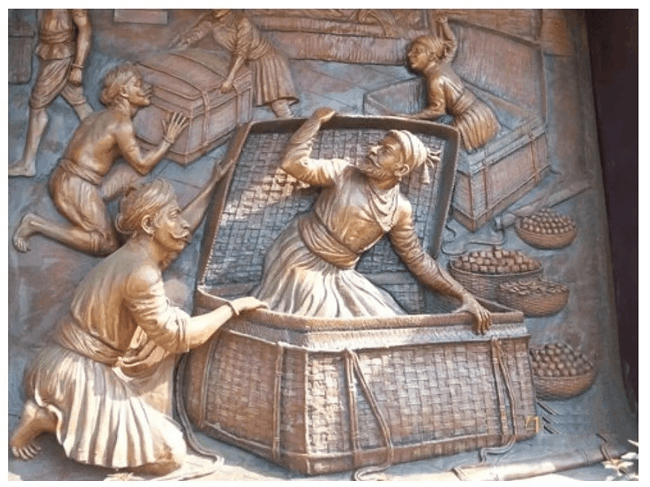
Peace with the Mughals
After Shivaji's departure, tensions with the Mughals waned, with Mughal Sardar Jaswant Singh serving as a middleman between Shivaji and Aurangzeb for fresh peace talks. Aurangzeb awarded Shivaji the title of "Raja" between the years 1666 and 1668. Sambhaji was also transformed back into a 5,000-horse Mughal mansabdar. Shivaji despatched Sambhaji and general Prataprao Gujar to work with Prince Mu'azzam, the Mughal ruler in Aurangabad. Sambhaji was also given land in Berar to collect taxes. Aurangzeb also permitted Shivaji to invade the dying Adil Shahi; the weak Sultan Ali Adil Shah II requested peace and gave the powers of Sardeshmukhi and Chauthai to Shivaji.
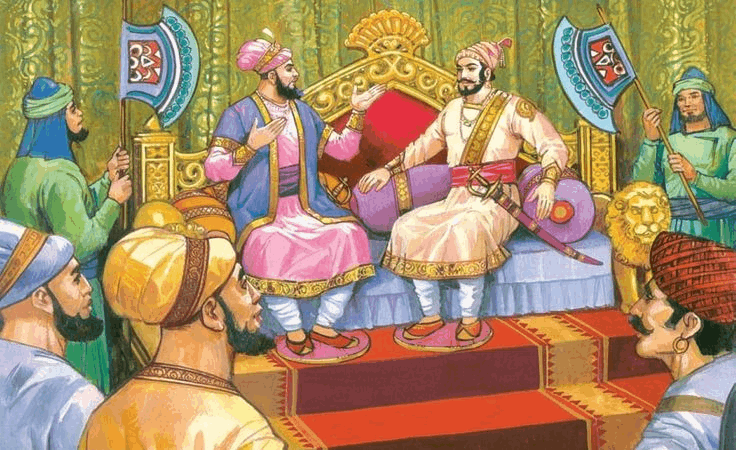
Reconquest
Until 1670, Shivaji and the Mughals were at peace with one another. At that time, Aurangzeb developed a mistrust of Mu'azzam, who he believed may take his throne and may even have been taking payments from Shivaji, given the strong relations between Shivaji and him. Aurangzeb also drastically decreased his army in the Deccan at that time since he was too busy fighting the Afghans; many of the dissolved troops joined the Maratha army almost immediately. To recoup the money they had loaned Shivaji a few years prior, the Mughals also took away his jagir of Berar. In reply, Shivaji began an attack against the Mughals, which resulted in the recovery of a sizable section of the lands that had given up within four months.
Shivaji took control of Surat for the second time in 1670. Although English and Dutch industries were able to withstand his onslaught, he still managed to take control of the entire city, including looting the belongings of a Muslim prince from Mawara-un-Nahr who was traveling back from Mecca. The Mughals continued fighting with the Marathas after becoming enraged by the repeated assaults, sending a force led by Daud Khan to stop Shivaji as he returned from Surat. Still, they were routed in the Battle of Vani-Dindori, close to modern-day Nashik.
The English had declined to supply Shivaji with military supplies, so in October 1670, he ordered his men to Bombay to bother them. His forces prevented English woodcutting crews from leaving Bombay. Shivaji sent an ambassador to Bombay in September 1671 to request more supplies, this time for the battle with Danda-Rajpuri. When Shivaji again took control of Surat in 1670, the English and Dutch forts could withstand his invasion. However, he managed to take control of the entire city, stealing the belongings of the Muslim ruler from Mawara-un-Nahr, who was traveling back from Mecca. When the Marathas continued their raids, the Mughals were angry and dispatched a force led by Daud Khan to stop Shivaji as he returned from Surat. However, destroyed in the Battle of Vani-Dindori, which took place close to modern-day Nashik.
The English had declined to supply Shivaji with military supplies, so in October 1670, he ordered his men to Bombay to bother them. His forces prevented English woodcutting crews from departing Bombay. Shivaji sent an emissary to Bombay in September 1671 to request more supplies, this time for the struggle against Danda-Rajpuri.
Battles of Umrani and Nesari
The invasion army, headed by the Bijapuri leader Bahlol Khan, was repelled in 1674 by Prataprao Gujar, the primary commander of the Maratha armies. After cutting off the enemy's water supply by surrounding a key lake, Prataprao's forces won the fight and imprisoned the opposing commander, which led Bahlol Khan to request peace. Shivaji warned Prataprao not to do so, but Bahlol Khan was freed and began preparations for a new invasion.
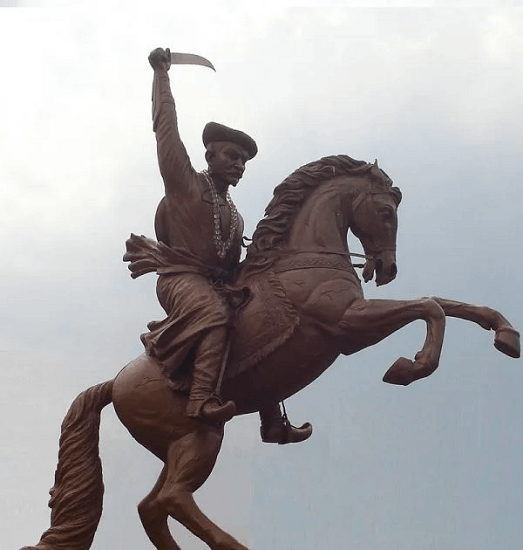
Shivaji refused to give Prataprao an audience until Bahlol Khan was conquered by a resentful letter delivered to Prataprao. Prataprao was furious at his commander's scolding and went in search of Bahlol Khan, leaving his main army behind and charging his position with only six additional riders. When Shivaji discovered that Prataprao had died in battle, he was devastated and made plans to marry Rajaram to Prataprao's daughter. Hambirrao Mohite took over as the next sarnaubat after Prataprao (commander-in-chief of the Maratha forces). Hiroji Indulkar recently constructed Raigad Fort to serve as the capital of the emerging Maratha empire.
Expansion of the Maratha Empire after Shivaji
A state in conflict with the Mughals was the legacy Shivaji left behind. The Marathas, the Adilshahi of Bijapur, and the Qutb Shahi of Golkonda ruled the respective lands. Soon after he died in 1681, Aurangzeb invaded the south to conquer these lands. He spent 27 years in the Deccan and succeeded in destroying the Sultanates, but he was unable to conquer the Marathas. Sambhaji was captured, tortured, and ultimately executed at this time, but the Marathas mounted a fierce defense under the guidance of Rajaram, Sambhaji's successor, and later Tarabai, Rajaram's widow. The Marathas and Mughals traded territories often until the Mughals were victorious in 1707 after a war.
During the 27-year battle, Aurangzeb imprisoned Shahu, Shivaji's grandson, and Sambhaji's son. His successor freed Shahu after the latter's passing. Shahu was the ruler of the Maratha Empire from 1707 to 1749 after a short fight for power over the succession with his aunt Tarabai. He nominated Balaji Vishwanath and his successors to be the Maratha Empire's Peshwas (prime ministers) early in his rule. When Balaji's son Peshwa Bajirao I and grandson, Peshwa Balaji Bajirao, were in charge, the kingdom significantly grew. The Maratha kingdom reached its greatest extent during this time, extending from Bengal in the east to Peshawar (modern-day Khyber Pakhtunkhwa) in the north. The Maratha army's imperial advance in northwest India ended in 1761 when they were defeated by Ahmed Shah Abdali of the Afghan Durrani Empire at the Third Battle of Panipat. Madhavrao Peshwa's leadership in North India brought back the Marathas' power ten years after Panipat.
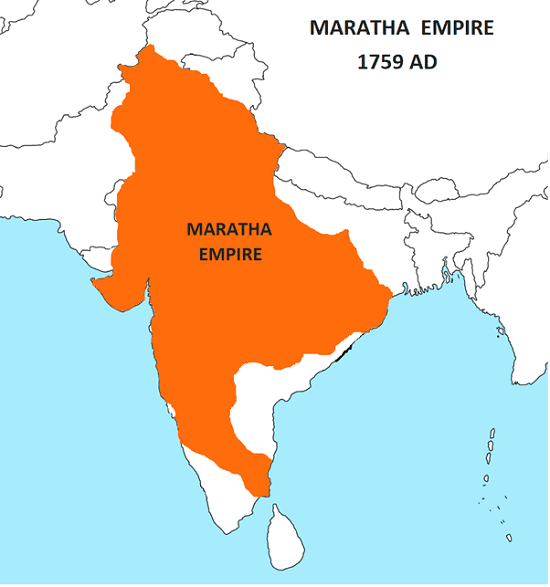
The Maratha Confederacy was founded when Shahu and the Peshwas granted semi-autonomous status to the most powerful of the knights to govern the vast kingdom efficiently. They became referred to as Baroda's Gaekwads, Malwa's Holkars, Gwalior's Scindias, and Nagpur's Bhonsales. The First Anglo-Maratha War began in 1775 due to the East India Company actively engaging in a succession dispute at Pune. When the British defeated the Marathas in the Second and Third Anglo-Maratha Wars (1805–1818), they took control of most of India. The Marathas had previously been the dominant force in the country.
Conquest of Southern India
Marathas launched an aggressive assault in 1674, attacking Khandesh in October, taking Bijapuri Ponda in April, Karwar in the middle of the year, and Kolhapur in mid-year (July). The Siddis of Janjira and the Maratha Navy engaged in a skirmish in November, although they did not drive them from their positions. When Shivaji recovered from his sickness and decided to assault Athani in April 1676, he took advantage of the civil conflict that had broken out between the Deccanis and the Afghans at Bijapur.
In the months leading up to his journey, Shivaji appealed to a feeling of Deccani patriotism, arguing that southern India was a country that ought to be guarded against invaders. After some progress with his appeal, Shivaji spent a month in Hyderabad in 1677 and signed a contract promising to break his union with Bijapur and unite with the Golkonda sultanate to fight the Mughals. Shivaji attacked Karnataka in 1677 with 40,000 soldiers and 30,000 cavalries, supported by Golkonda artillery and money. Shivaji took the forts of Vellore and Gingee as he moved south; the latter would subsequently become the Maratha capital during the rule of his son Rajaram I.
Shivaji wanted to make amends with Venkoji (Ekoji I), the son of Shahaji's second wife, Tukabai (née Mohite), who succeeded Shahaji as the ruler of Thanjavur (Tanjore). When the originally lively discussions fell through, Shivaji defeated his half-brothers on November 26, 1677, and took control of most of his property on the Mysore plateau while traveling back to Raigad. Shivaji had great regard for Dipa Bai, the wife of Venkoji, who engaged in new discussions with him and persuaded him to stop dealing with his Muslim advisors. Finally, with Venkoji's agreement to several stipulations for the appropriate management of the regions and upkeep of Shahji's memorial, Shivaji agreed to hand up to her and her female descendants much of the assets he had taken (samadhi).
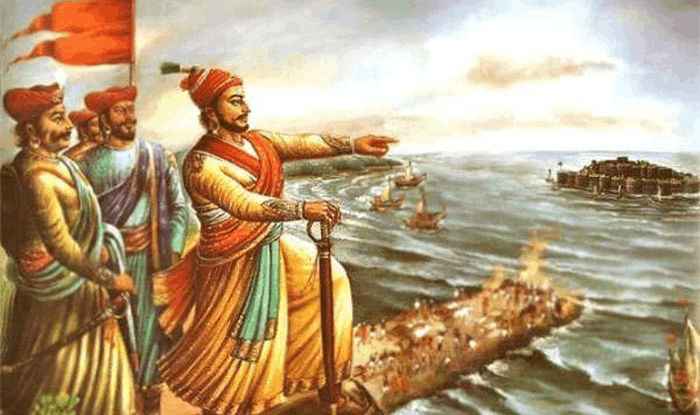
Shivaji's Mode of Warfare
Shivaji had a small but efficient standing army. Peasants from the Maratha and Kunbi castes made up most of Shivaji's army. He knew the restrictions of Shivaji's army. He understood that using traditional fighting techniques wouldn't be enough to defeat the Mughals' large, well-trained cavalry armed with field artillery. Shivaji thus employed guerrilla strategies called "Ganimi Kawa." Shivaji was an expert in guerilla combat. Armed forces dispatched to stop him were often baffled by his techniques and routed. He used his local terrain expertise and his light cavalry's greater mobility to block the enemy's supply lines. Shivaji avoided engaging in physical warfare. Instead, he led the adversaries into challenging hills and forests of his design, capturing them off guard and destroying them. When necessary, Shivaji employed various strategies to weaken his adversaries, including surprise raids, sweeps, ambushes, and applying psychological pressure.
Shivaji's guerilla warfare of assaulting enemy armies and fleeing into his mountain forts earned him the derisive nickname "Mountain Rat" from Aurangzeb and his generals.
Military
When Shivaji built his military organization, which endured until the fall of the Maratha Empire, he displayed considerable talent. He planned to use a combination of his forts spread around his realm, naval troops, and land forces. His ground troops were primarily Maval infantry, with Maratha cavalry providing assistance and Telangi musketeers from Karnataka for reinforcement. Additionally, he was encouraged to use a very mobile battle because his artillery was quite weak and dependent on European supply.
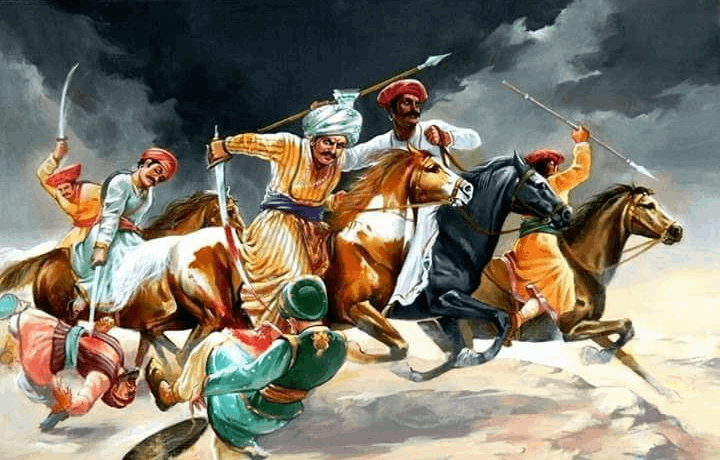
Hill Forts
Shivaji's plan mostly depended on hill forts. He conquered significant forts at Purandar, Murambdev (Rajgad), Torna, and Kondhana (Sinhagad). Additionally, he constructed or renovated several forts in favorable positions. Shivaji also constructed several forts; although some stories list "111," it is more probable that the actual number "did not surpass 18." Shivaji owned between 240 and 280 forts at the time of his death, according to historian Jadunath Sarkar's estimate. Each was assigned to three officers of equal rank to prevent a single traitor from being bought off or persuaded to give it to the enemy. The officers cooperated and supplied one another with checks and balances.
Navy
Shivaji started assembling his fleet in 1657 or 1659 when he bought 20 galivats from Portuguese shipyards in Bassein. Shivaji was aware of the necessity for naval strength to retain authority along the Konkan coast.
Marathi histories claim that at its peak, his fleet included 400 vessels; however, English chronicles of the time dispute this claim, saying that the fleet's size never surpassed 160.
The chief of the Maratha Navy was Kanhoji Angre. Because Marathas were used to land-based military, Shivaji expanded his search for skilled personnel for his ships. He took on Muslim mercenaries and lower-caste Hindus from the coast who had experience in naval warfare (the infamous "Malabar pirates"). Shivaji appointed Rui Leitao Viegas as the commander of his fleet after taking note of the Portuguese navy's strength and hiring some Portuguese sailors and Goan Christians. Later, Viegas returned to Portugal and brought 300 sailors with him.
By capturing and renovating coastal forts, Shivaji reinforced his shoreline. He also constructed his first marine fort at Sindhudurg, which would later serve as the Maratha Navy's administrative center. The navy was not designed to move far out to sea; instead, it was a coastal force that prioritized movement and fighting in coastal regions.
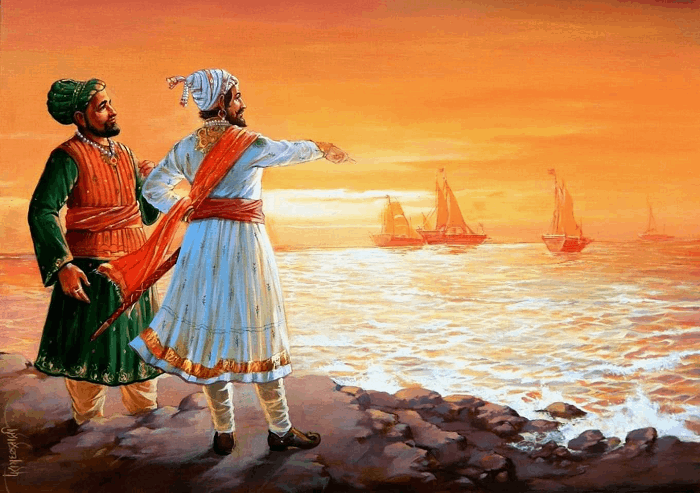
Death and Succession
It took a lot of work to determine Shivaji's obvious heir. In 1678, Shivaji imprisoned his son in Panhala, but the prince eventually escaped with his wife and spent a year fighting with the Mughals. Sambhaji made an unrepentant return to his home and was imprisoned in Panhala.
On the eve of Hanuman Jayanti, approximately April 3–5, 1680, Shivaji passed away at 50. It's unclear what killed Shivaji. According to British archives, Shivaji died after suffering from a bloody illness for 12 days.
Anthrax is listed as Shivaji's manner of mortality in a modern Portuguese book, the Biblioteca Nacional de Lisboa. Shivaji's death was attributed to fever, according to Krishnaji Anant Sabhasad, the author of Sabhasad Bakhar, the biography of Shivaji. The oldest and only childless wife of Shivaji, Putalabai, performed sati by plunging into the cremation fire. Sakwarbai, another survivor's spouse, was prohibited from doing the same since she was the mother of a small child. Assertions that his second wife Soyarabai had poisoned him to install her 10-year-old son Rajaram on the throne also existed; however, historians eventually cast these claims into question.
After Shivaji's passing, Soyarabai arranged with several government ministers for her son Rajaram to succeed her stepson Sambhaji as king. Rajaram, who was ten years old at the time, was crowned on April 21, 1680. However, after murdering the commander, Sambhaji seized control of Raigad Fort, took over the city on June 18, and formally became the monarch on July 20. As a result of conspiracy allegations, Rajaram, his wife, Janki Bai, and his mother, Soyrabai, were all put in prison, and Soyrabai was put to death in October.
Controversy
The Mughal Empire had an impact on Shivaji's manner of rule, according to a 1993 article in Illustrated Weekly, which also claimed that Shivaji was not inherently anti-Muslim. Members of the Congress Party demanded that legal action be taken against the publisher and writer; Marathi media accused them of having "imperial bias," and the Shiv Sena demanded public shame of the writer. Maharashtra filed a lawsuit against the publication under laws that forbid hostility between religious and cultural groups. Still, a high court determined that Illustrated Weekly had used its right to free expression.
James W. Laine, an American researcher, released Shivaji: Hindu King in Islamic India in 2003 in response to what Ananya Vajpeyi considers a system of "culture surveillance by militant Marathas." The Sambhaji Brigade assaulted the Bhandarkar Oriental Study Institute in Pune, where Laine had conducted research as a reaction to this article. The book was also banned in Maharashtra in January 2004, after Laine had even received threats of arrest; however, the Bombay High Court removed the prohibition in 2007, and the Supreme Court of India upheld it in July 2010. After this lifting, public protests against the author and the Supreme Court's ruling occurred.
Commemorations
Shivaji is remembered across India as a whole, although Maharashtra is where most of them are. Shivaji's memorials and statues can be seen practically everywhere in Maharashtra and other parts of India. Additional commemorations may be seen at Mumbai's primary airport and railway headquarters, at the Indian Navy's station INS Shivaji and on various postage stamps. During the Diwali holiday, children in Maharashtra have a long-standing custom of creating a model fort in Shivaji's honor using toy soldiers and other sculptures.
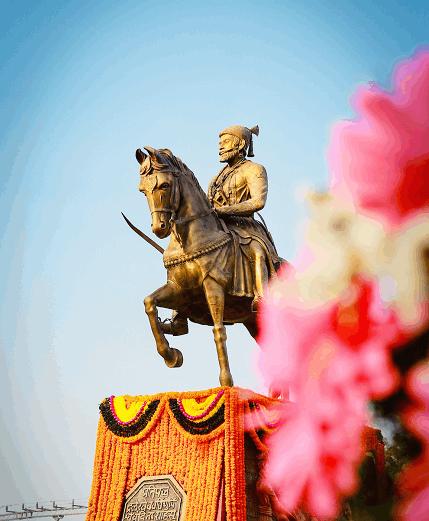
In 2016, a plan to construct a massive memorial known as Shiv Smarak was authorized. It would be situated close to Mumbai on a tiny island in the Arabian Sea. When it is finished, likely in 2021, it will stand 210 meters tall, making it the biggest statue in the world.
A monument constructed of gunmetal was dedicated in Pune in March 2022.